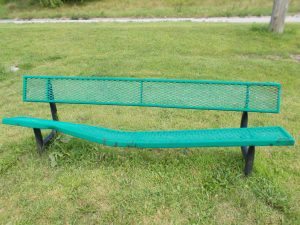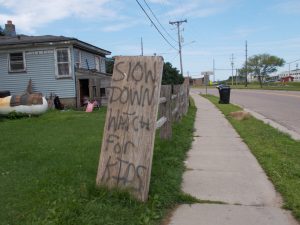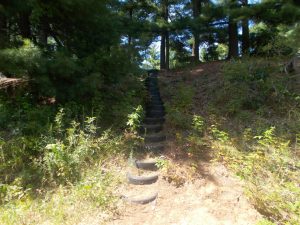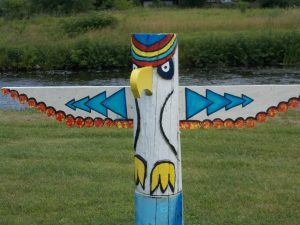Contact: Kim Beaumier, Project Manager, 715-799-6226 ext. 5712 or kimberly.beaumier@wisc.edu
The Menominee Indian Tribe of Wisconsin, along with community partners in Menominee County/Nation, including University of Wisconsin-Madison Division of Extension, is taking steps to restore traditional Menominee food and activity practices that promote health, with support from a five-year grant from The National Centers for Disease Control and Prevention (CDC).
The project, known as Kemāmaceqtaq (“We’re All Moving” in Menominee language), aims to strengthen the indigenous food system, implement policies that promote access to healthy foods, and create opportunities for movement, including walking, biking and traditional games. The effort wrapped its first year in September 2019.
“The goal for the first year of the grant was to deepen our understanding of community priorities related to nutrition and physical activity,” said Kim Beaumier, Extension project manager for Kemāmaceqtaq. “This will set the stage for further action in year two and beyond.”
One of the year one activities included “walk audits” of Keshena and Neopit, two Menominee communities, on June 13, July 12 and August 7, 2019. Walk audits help point to aspects of the “built environment”—such as roads, parks and trails—that affect people’s ability to be active. Youth and adults walked through the community together for six hours each of the three days of the walk audit, which supported intergenerational learning.
Adults were able to share what the community looked like when they were children. The youth talked about what they observed about their current environment.
“There is a certain perspective that you can only get as a child growing up here,” said Jeremy Weso, Highway Commissioner of the Menominee County Highway Department, at an October 17 partner meeting. “When I was a kid growing up on the reservation, I knew every trail. I knew where the fences were that were easiest to cross. I knew where the mean dogs were.”

Youth identified this broken park bench as needing improvement. Beautifying park spaces can promote physical activity.
“You see the community through a different lens when you are [an adult] driving it,” said Weso. “This walking assessment, and seeing how the kids talked about the community, it really brought me back. Working with young people was a rich experience.”
The youth took photos and discussed what they observed. They also learned how to use GPS units to document environmental features they liked and did not like.
“On the first day of the walking assessment, the youth were a little shy,” noted Jennifer Gauthier, UW-Madison Extension Menominee County/Nation Community Development Educator, who organized the walking assessment.
“All it took was that first walk to [Keshena] Falls, and they started talking and laughing and sharing their perspectives. Every day we took a walk, they opened up a little more.”
The youth identified areas in need of improvement: broken benches, sidewalks in disrepair, screws loose at the Neopit Skate Park, and an unmarked stretch of highway that children must cross to access swimming areas.

A walk audit within Menominee County/Nation identified this sign created by a community member in Neopit, Wis.
They also identified community assets, including the beauty of the natural environment, recreation spaces including wild rice areas, trails, shortcuts and community efforts to beautify public spaces, like Native artwork and “Slow down, watch for kids” signs.
The path forward will include interventions grounded in Menominee cultural values and the community feedback collected to-date.
For example, Lee Stoehr, Menominee County Finance Director, expressed a desire to reduce or minimize light pollution within the community. He noted that street lights – often touted as a safety measure—are not aligned with his ideal vision for the community.
“Look at what we have developed,” said Stoehr, noting recent development in Keshena and the surrounding communities. “For example, street lights. A lot of people see that as progress. That’s not what I personally want to see. I want to be able to look up at the sky and see the stars.”
The exact interventions that will be implemented in year two and beyond are still being finalized. The final work plan will be dependent upon available budget and which strategies are aligned with CDC funding guidance.

A “desire path” photographed during the audit walk identifies a route community members prefer to travel.
Ideas for next steps proposed at the October 17 partner meeting include the following:
-
-
-
-
-
-
-
-
- Improve local trails or add signage indicating distances to local sites.
- Improve park infrastructure, including benches.
- Plant an edible perennial landscape.
- Create “slow down” signs featuring Menominee language and art.
- Conduct food preservation training to community members.
- Develop new policies to strengthen connections between local growers and institutions.
- Create nutrition standards that promote health and sustainable choices at community sites.
-
-
-
-
-
-
-
For more information visit Extension Menominee County/Nation Facebook page, the Menominee County/Nation website and the Kemāmaceqtaq Flickr page.




